

Small Craft Advisor

Review: Sea Pearl 21
Convenient and capable, the marine concepts sea pearl is a trailersailing jewel..
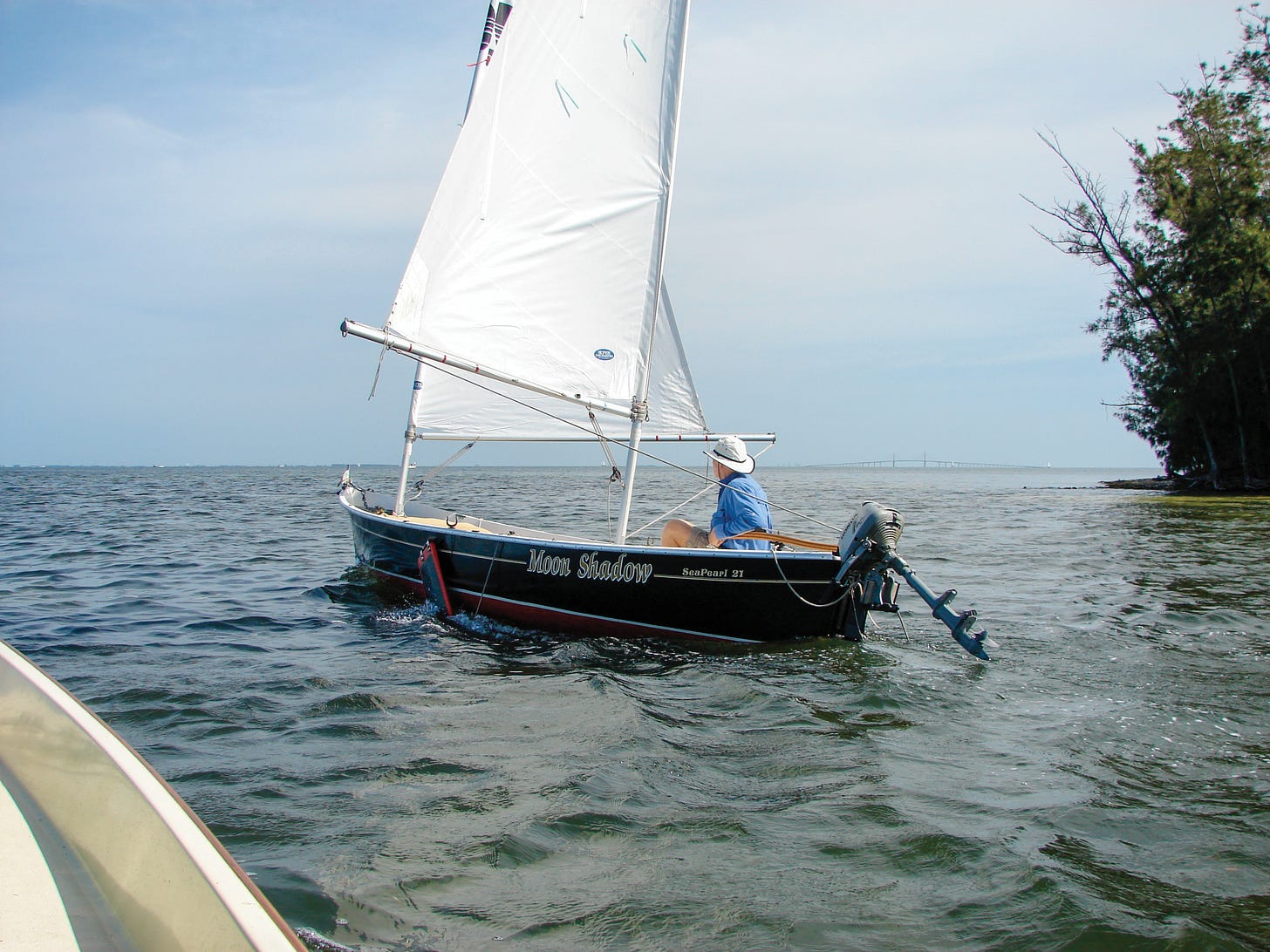
The eminent L. Francis Herreshoff called his Walrus design a “man’s boat.” A motorsailer, Walrus carried 755-square-feet of sail, two 65-horsepower gasoline engines, and a pot-bellied stove in her saloon. She was ideally suited to the cold-weather expedition.
Her only weakness, especially in the eyes of a venturesome coastal-cruising captain, was her six-foot draft. Herreshoff thought Walrus deserving of an able tender to serve as a secondary cruising boat for exploring shallows; this boat he called Carpenter.
A double-ended 18-footer, Carpenter was designed to carry substantial loads even through rough water. She was also intended to be easily beached—drawing a mere five inches with her centerboard retracted into her flat bottom. So impressed with the Walrus’ tender was Herreshoff that he wrote, “it might become something of a question as to which boat was tending which.”
In 1979, fifty years after Herreshoff ’s sketches, George Jeffries and Ron Johnson formed a boatbuilding partnership called Marine Concepts. Their first “concept” was a family boat based on Herreshoff ’s Carpenter. Expanded to 21 feet, their “Sea Pearl” maintained the length-to-beam ratio of the original. Not quite double-ended, the Sea Pearl had a narrow tombstone transom.
Early versions employed a centerboard, but by the eighties leeboards were being offered. The leeboard model excelled in shallow water, since the boards remain somewhat functional while drawing no more than the hull. And the absence of a centerboard trunk meant more room inside the forward cockpit or under the optional canvas cabin. Centerboard Pearls were soon all but obsolete.
Early models were unballasted, but since 1988 most have a hull liner and water ballast tanks that when full add 360 pounds. The unique reefing gooseneck system was added by 1990. Four hundred-nineteen monohull Sea Pearls had been built when we wrote out initial review in 2004 (see issue #25). Marine Concepts remained “in the family,” operating under the watchful eye of owner Jim Leet—Ron Johnson’s brother-in-law. At that time we asked Jim about his typical customer.
“Most of our business comes from 60 to 80-year-olds. The Sea Pearl is so easy to rig and launch that older folks really like them.” Leet sees tremendous potential for his lightweight, rowable, sailable Sea Pearl in another market as well. “I’d also like to get the younger camp-cruise, kayak and canoe crowd. Our boat would be the absolute Cadillac of their market.”
We sailed with owner Drew Squyres aboard his 1991 model, Persuasion, and we asked the real experts—Sea Pearl owners—for their comments.
Note: Before publishing this article we reached out to Marine Concepts and didn’t get a reply. We were told by one Sea Pearl owner (but were not able to confirm) that Marine Concepts has ceased production of new boats, but that Jim Leet is possibly still selling accessories.
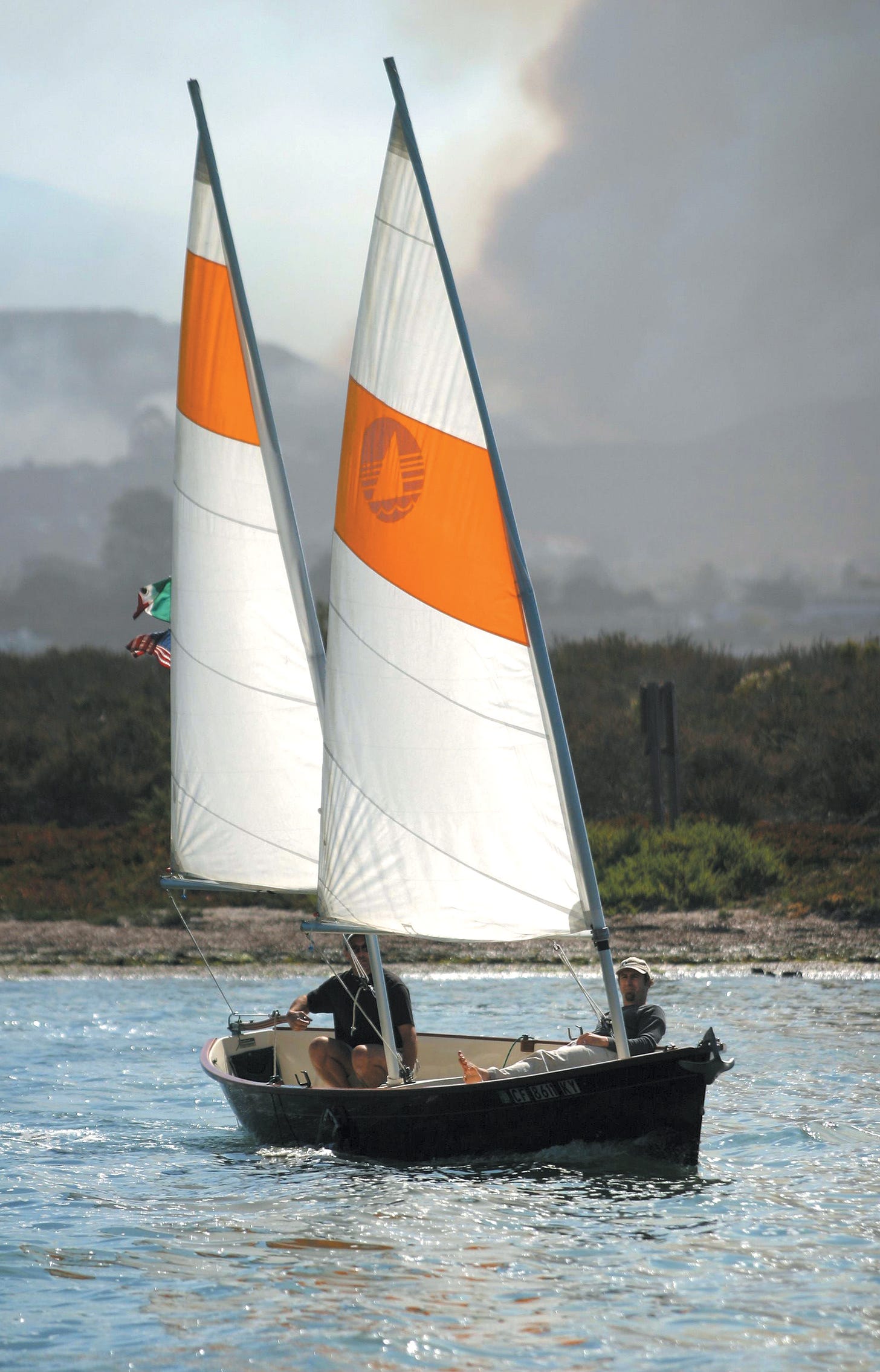
PERFORMANCE:
“I have sailed along side a Drascombe and Bay Hen and had to luff both my sails to keep my speed down to theirs. Downwind, the ability to go wing-onwing in air too light to sustain flying a spinnaker cannot be matched.” Steve Churchill, 1993 Silmaril.
“People claim to tack through 90 degrees. I guess you can, if you’re pointing to the max. I prefer to sail about 55 degrees off the wind for a little more speed.” Phil Bacon, 1986 Scout .
“In a light breeze I get 3-4 knots easily. When the wind is over 10 knots, I consistently get 4.5 to 5.5 knots upwind and 6 to 6.5 knots downwind. I’ve surfed occasionally over 7 knots.” John Weiss, 1998 DragonSong.
“The Sea Pearl is a family and recreational cruising boat, not a racing boat comparable to Flying Scots, Lightnings, Thistles, etc. Still, it is quite fast—commonly the fastest boat overall of a group of various trailerable cruisers such as the West Wight Potters, O’Days, Drascombes, Wayfarers, Dovekies, Hen boats, Sanibel, Com Pacs, etc. The 21 does not point well. The cat ketch rig, shallow draft, and leeboards in lieu of a keel or center/daggerboard all work against sailing close to the wind. I have found that about sixty degrees off of the wind is the best I can do in good conditions. In rough seas, achieving even that upwind success requires close attention to such things as weight distribution and tell-tales.” Bill Fite, Moon Shadow.
“Not as fast upwind as some, but often passes boats on a broad reach and downwind. Points fairly well, and sailing close-hauled is fun because it likes that initial heel, but some sloops can certainly out-point her at times. The lug rig has some mysteries I never fully solve, because sometimes I’m amazed how well it does even when close-hauled.” Tom Lyons, 1984 Besito (lug rig).
In a dead calm, we had a chance to test the Sea Pearl’s standard auxiliary propulsion system—9-foot oars. Drew rowed while I manned the tiller—later we switched. We pulled our way quietly through the desolate back bay. Almost any small boat can be made to row, but there’s a clear difference with those in which rowing was a design consideration. The Sea Pearl goes well. She’s too heavy to move like a. rowboat or racing shell, but if I owned her I think I’d frequently leave the outboard at home. I’d be tempted to make her an exercise machine in the morning’s light air and sail home on the afternoon sea breeze.
After rowing to a shallow spot near the dunes we unfurled the sails in an attempt to catch the freshening breeze. Sure enough the Pearl responded. The cat-ketch rig’s 136-feet of sail area was just enough. Light air performance was good.
Sixty minutes later the Santana arrived in force. Our mirror-like reflection on the water was shattered by whitecaps. Drew suggested we fill the tanks. “It’s like giving her a glass of wine,” he said, “the extra ballast relaxes her and takes the edge off.” The Pearl felt more substantial now—especially hard on the weather, clipping the tops off the foamy swells.
We were surprised when the wind built to a sustained 17 knots. Drew demonstrated another Sea Pearl strength—heaving to. Ease the main, harden the mizzen and let go. The boat weather-vaned, drifting slowly backward—the rudder turned sideways and acted as a brake. To reef, Drew lifted the thumb tab on the ingenious rotating gooseneck, unclipped the vang and eased the outhaul. This allowed him to rotate the mast— which spins freely in the mast tube— and roll up sail area. Very simple. Very Sea Pearl.
To keep a balanced rig we reefed using the Sea Pearler’s standard “3/2”— three turns on the main and two on the smaller mizzen. This leaves the Pearl—which can be set to sail with a neutral helm in any conditions—with a slight weather helm for assistance rounding into stronger gusts. To resume sailing Drew simply backed the mainsail, which was right at his fingertips. Obviously, traditional battens won’t fly on these roller-reefing masts but the factory does offer special vertical batten performance sails as an upgrade.
Even under reduced sail the Sea Pearl performed admirably. She was fast and predictable—and pointed fairly well. Owners told us Sea Pearls tack in 90-110 degrees. The truth is somewhere in between; not quite as good as a similar sloop-rigged centerboarder, but not bad.
The split rig is essentially self-tending, that is, her skipper can ignore the sheets on tacks. Push the tiller over, lower the leeward board, and raise the windward board. Optionally, the Pearl can be sailed less efficiently with both boards down as some owners do in short tack situations.
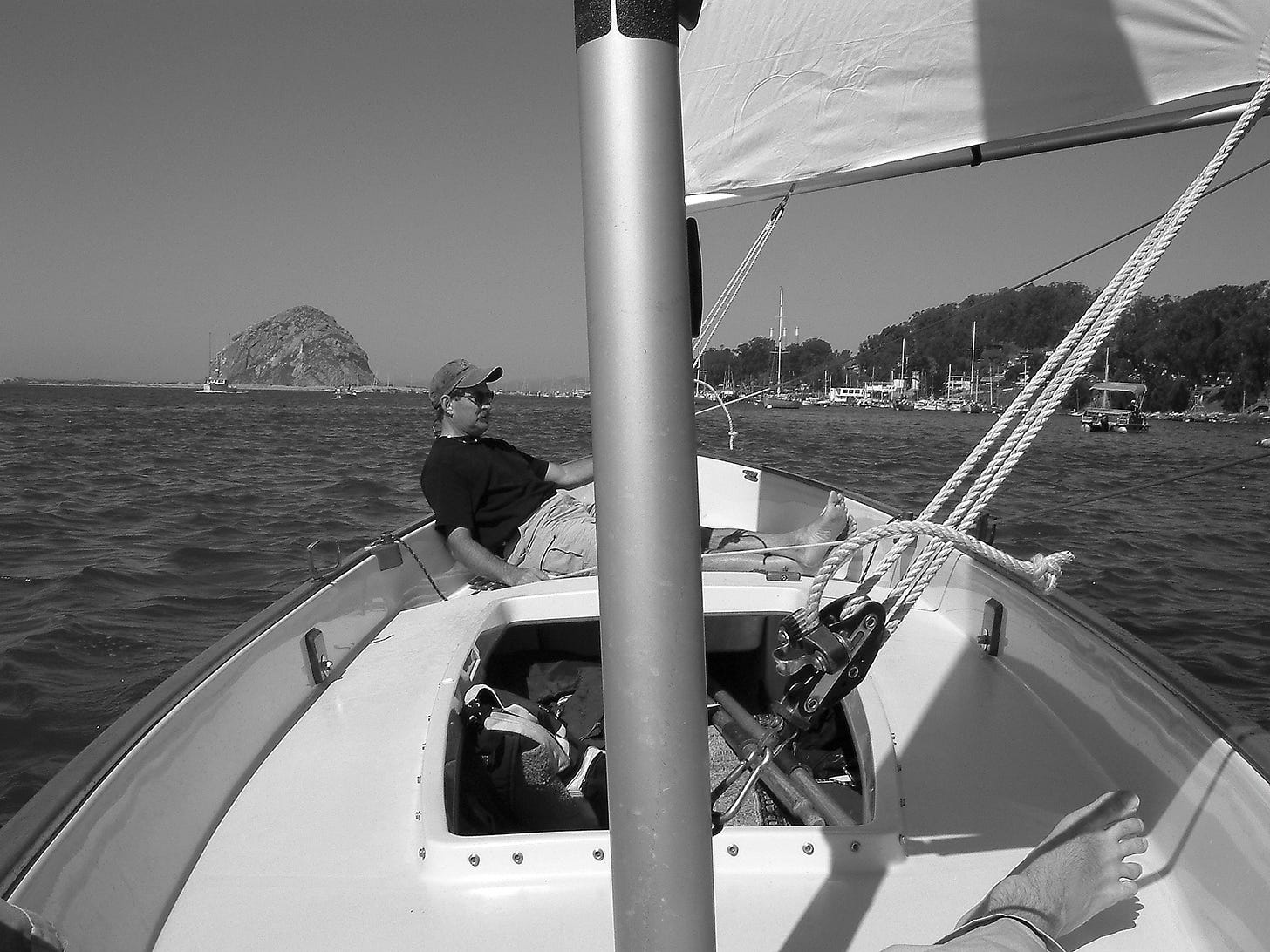
TRAILERING AND LAUNCHING:
“Even my 1982 Saab hauls it at highway speeds with ease. It sits so low on the trailer, it’s stable even in crosswinds . . .I blew a trailer tire at 65 mph and didn’t even know it except for a bit of rumbling noise from the wheel on the pavement” John Weiss, 1998 DragonSong
The lightweight Sea Pearl is one of the few trailerables appreciably lower than her tow vehicle. She also sits low, so the view in the rearview mirror is less impaired. Few boats are easier to tow.
We were ready to participate in the rigging and launching of Drew’s Persuasion, but we didn’t have a chance to do much—Drew had already stepped both masts and rigged in the time it took us to snap a few pictures. Many owners claim to rig and launch in less than 8 minutes—and we believe it.
Launching is even easier. Drew showed us how, with his tilt trailer, the Pearl can be launched without dunking the trailer hubs. That’s right—not just dry automobile hubs—but dry trailer hubs. A gentle push and the boat slid right off. Drew deftly played bow and stern lines to turn his boat toward open water, tied off at the dock, and we were ready to go.
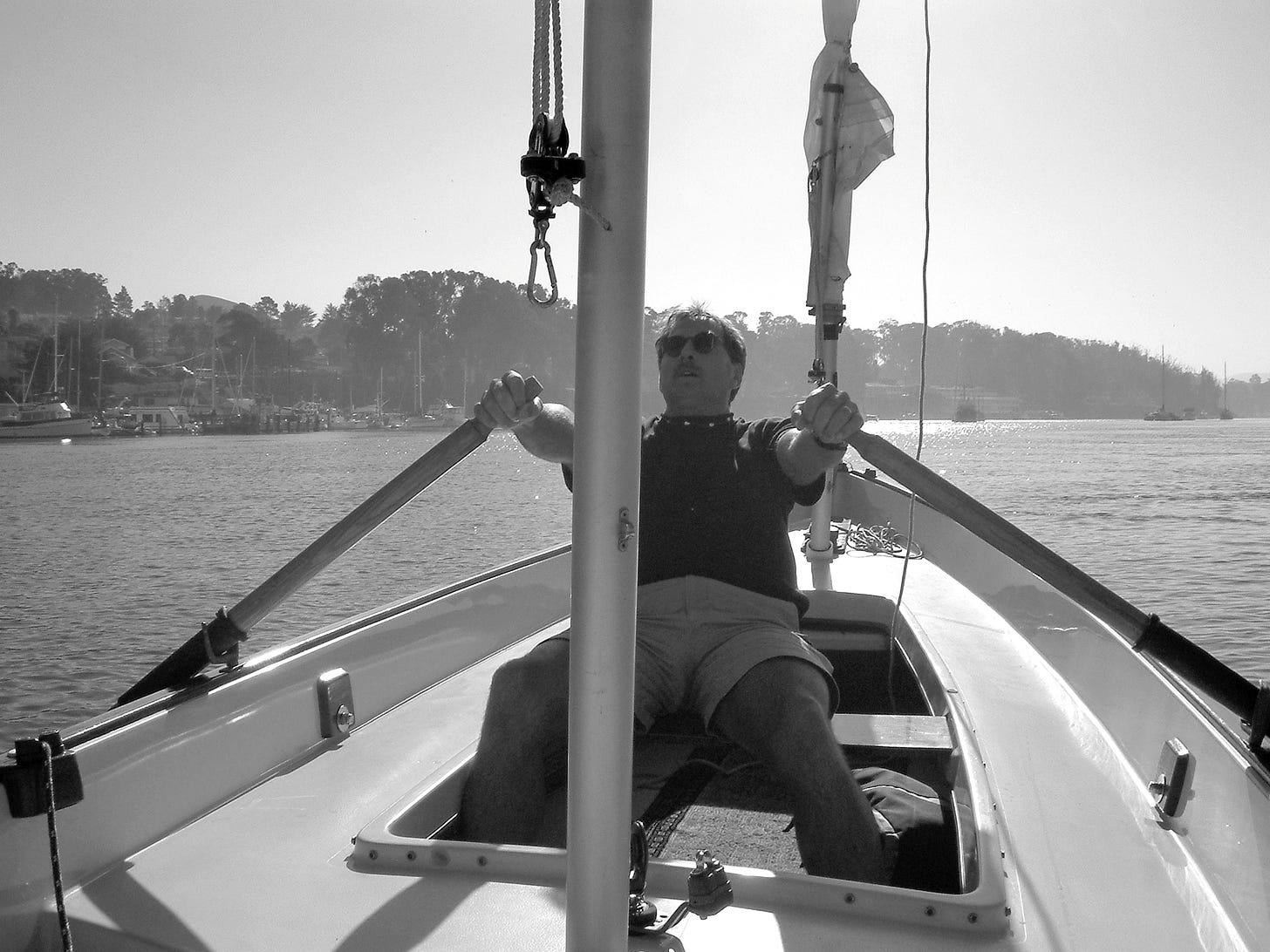
SEAWORTHINESS :
“I had my Pearl out in tropical storm Frederick in 1988 with winds of 45 knots, with sails reefed down to tiny size. We not only didn’t capsize, but made near hull-speed upwind. I had her offshore (along the coast) in 12-foot waves and stayed dry and in complete control.” Steve Churchill, 1993 Silmaril.
“I use ballast tanks whenever I’m alone, or in more than 12 knots or so. In combination with prudent reefing, she keeps right on going.” Phil Bacon, 1986 Scout.
“So far, so good. My boat does NOT have water ballast as many newer models do, but I really don’t want it. My only worry is in a possible breach situation when we are unavoidably crossways to big surf, but I have never rolled the boat or had it knocked down despite some adventurous chances. I do know the 21-foot length is a lot for its somewhat narrow beam and this helps when going upwind in a chop. The boat feels a bit light in big winds but it can take water over the rail without any problem because it just flows back to the cockpit and drains readily” Tom Lyons, 1984 Besito (lug rig).
Who can forget small-boat adventurer, Shane St. Clair’s account of sheeting the mizzen tight and going below to get some sleep in a 40-knot blow near Cape Hatteras. (SCA #13). In total darkness, surrounded by angry seas, St. Clair crawled forward, closed his eyes and left his Sea Pearl to fend for them both.
One look at the 600-pound Pearl, with its minimal freeboard and lack of a fixed cabin, and you’ll appreciate St. Clair’s courage. But Sea Pearls have been employed for a number of ambitious journeys.
She’s not only an able sailer, but also easy to reef and easy to beach—two qualities that add to a small-boat’s seaworthiness and versatility. Many owners laud their boat’s performance in high winds and big seas.
The Sea Pearl is not exempt from the realities of a narrow, relatively light, open boat. It’s possible to swamp or capsize her, and we’re told she can be difficult if not impossible to self-rescue. A few owners prepare for this unlikely possibility by adding more foam flotation to the hull and masts, but we’ve several reports of Sea Pearls bring towed to shore upside down.
Pearls benefit from hearty construction and a basic simplicity. The split rig means both low-aspect sails are easily manageable—neither requires winch or mechanical advantage. And unlike a centerboard, the leeboards are totally open to inspection and unlikely to jam with rocks or sand.
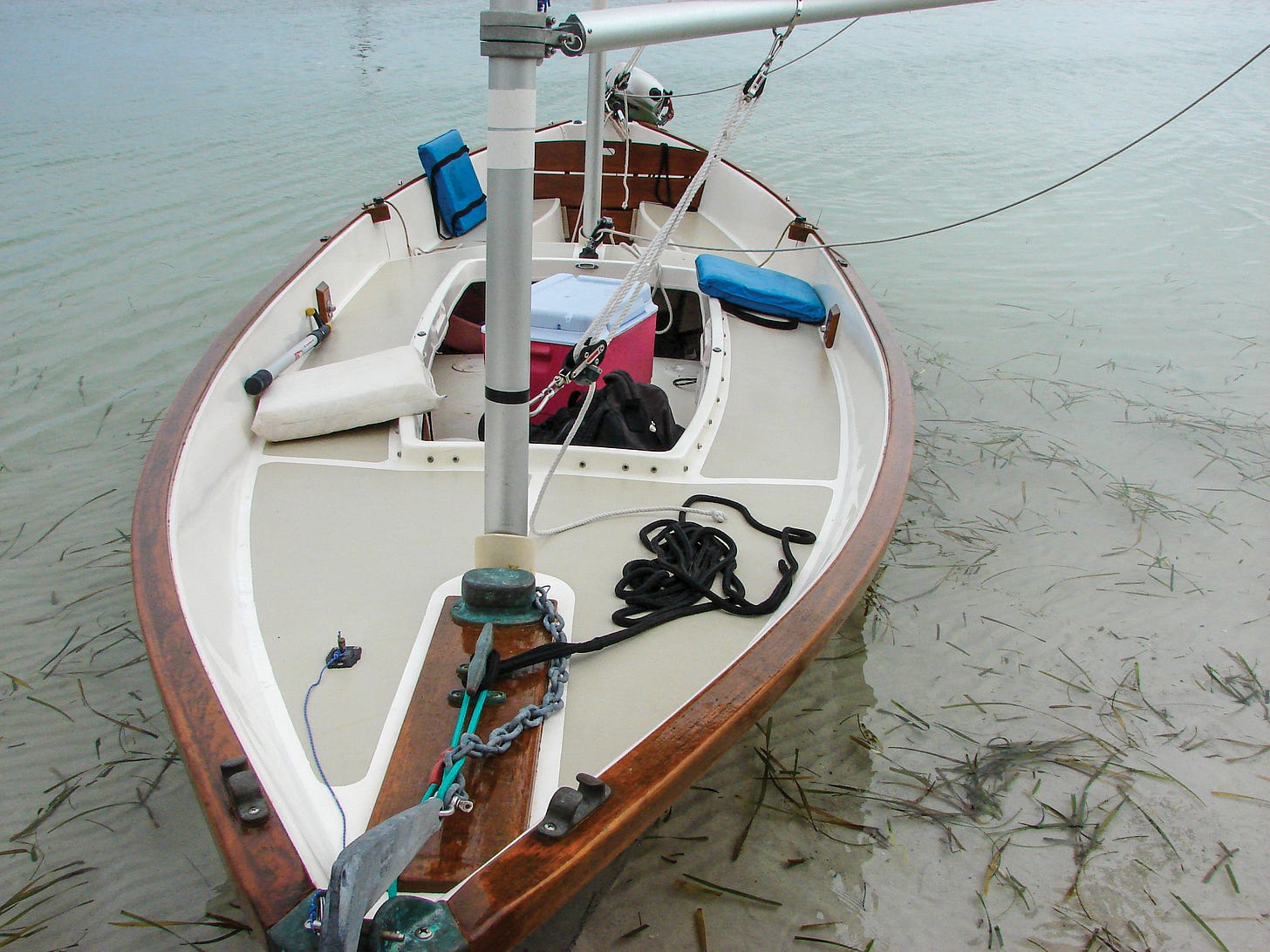
ACCOMMODATIONS:
“I think four can daysail comfortably, but three is great for balance and stretching out. For overnight, one can sleep in the center cockpit and one on the stern platform I made from folding plywood. Three of us have done extended cruising in the Sea of Cortez, but we slept on the beach and set up a full-blown camp. If you treat the Pearl as you would a big backpack, she will hold weeks worth of stuff. Of course, I never took three dozen tortillas and a case of Negra Modello on a backpacking trip.” Drew Squyres, 1991 Persuasion .
“ There’s plenty of room, but a lot of it is in inconvenient shapes or locations. (e.g., stowage racks under side decks are too shallow; space under cockpit is voluminous but hard to access).” John Weiss, 1998 DragonSong.
As a daysailer the Sea Pearl is one of the more accommodating small boats on the market. Six people for an afternoon sail is said to be plenty comfortable. Under-deck storage is good, with most owners customizing the space with storage boxes or duffel bags.
Overnighting aboard below the tonneau cover, optional convertible cabin (3' 6" headroom), or a canopy of stars (limitless headroom) is comfortable enough for two persons—if a bit spartan. Drew Squyres constructed his own aft tent to cover an aft berth made with plywood filler boards. This combination creates a giant caravan suitable for more extended cruises.
There is no designated spot for head or galley. Cruisers typically carry buckets, camp stoves, air mattresses, and other tent-camping gear.
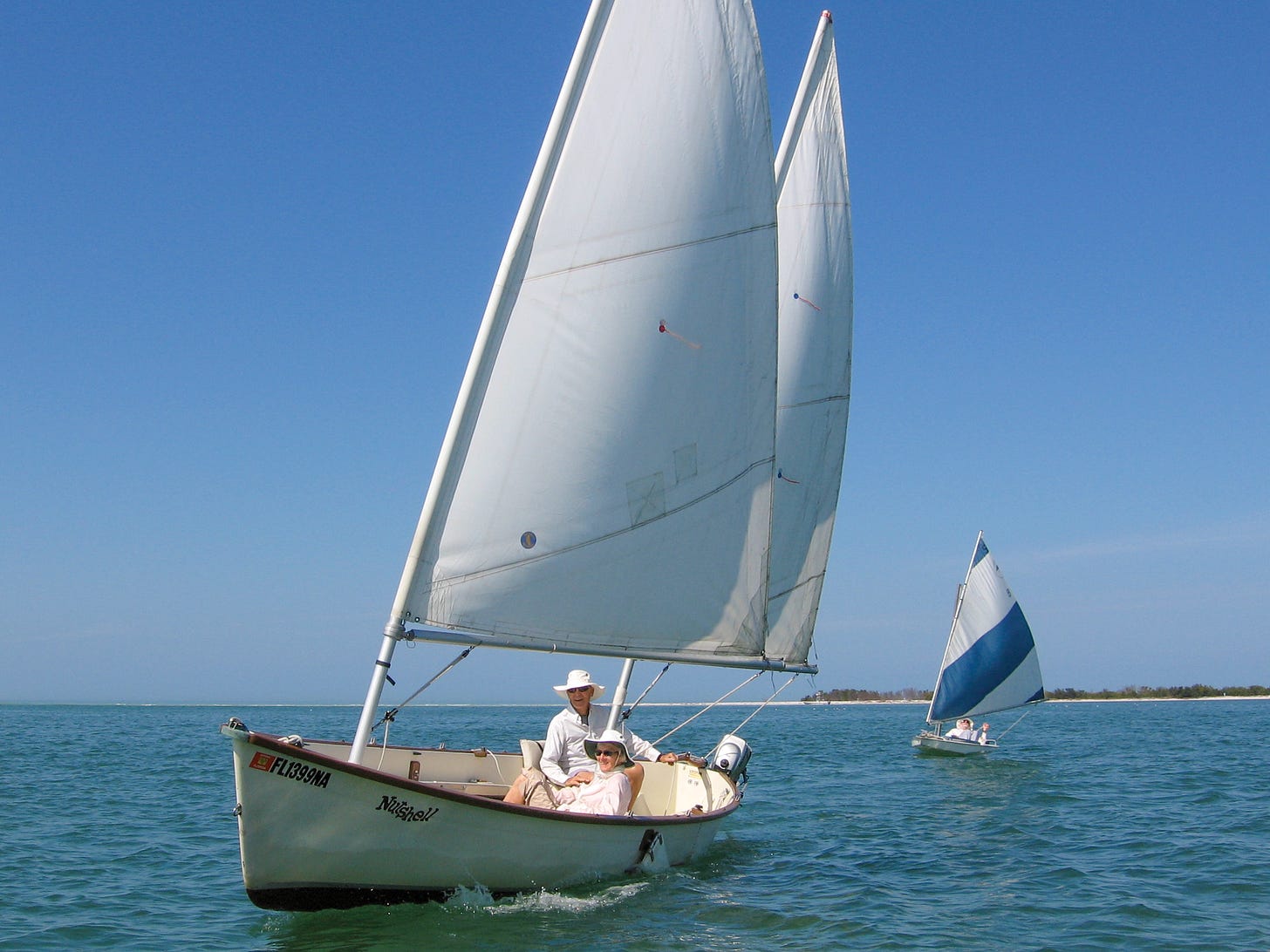
“At 34 years old (the boat, not me), I have replaced some wooden spars (cheap and easy) on the lug rig and repaired a lee board that was losing a lead shoe. Most Sea Pearls have the aluminum marconi rig, which must last forever. (But mine looks cooler and gets under low bridges better!) Virtually everything that can break is fixable with some line and a few minutes of creative rigging.” Tom Lyons, 1984 Besito (lug rig).
We asked owners about all aspects of construction, trying to uncover any pattern of failure or corner-cutting. Owner responses bordered on the mundane. A bent cleat, some faded paint—very little trouble of any consequence. The only significant report we heard related to some leaky ballast tank seams. Potential owners might want to double-check this system.
Marine Concepts cores the Pearl’s double-laminate hull and deck with Klegecell™ (cross-linked PVC), where older models used end-grain balsa. We crawled around Drew’s boat, pushing and pulling, and were impressed with both strength and finish.
Jim Leet tells of one Sea Pearl that fell from its trailer at 70 mph. The owner reportedly picked up the scattered components and sailed that afternoon.
COMPROMISES:
“You can’t throw it on top of your car, and you can’t put a queen-sized bed in it. It’s a perfect compromise between those two.” Drew Squyres, 1991 Persuasion .
“You forgot to ask about shallow-water worthiness. That’s where this boat shines. The Sea Pearl can go just about anywhere a kayak can go. With lee boards barely in the water she can work her way upwind. Stick the boat on a sandbar 5” deep and it still usually floats free as soon as you step onto the sand. For exploring little islands and mangrove lagoons that other sailboats have to steer clear of, the Sea Pearl is wonderful. And it is great for taking shortcuts where other boats must go around. . Who needs channels?” Tom Lyons, 1984 Besito (lug rig).
We’ve touched on some compromises already. The Sea Pearl is essentially open, so the boat and her crew are more exposed than they might be on a cabin cruiser, and accommodations are comparatively rudimentary. Some sailors—and especially non-sailors—are put off by the Pearl’s initial tenderness, although she stiffens up considerably once heeled. The Sea Pearl is nearly defined by its cat-ketch rig and leeboards, which are both compromises—trading certain virtues for others—but we think the net results are positive.
MODIFICATIONS:
“I bought an aftermarket rudder for about $400 in hopes of getting extra lift for perhaps a bit of extra speed or higher pointing. Every penny of that cost was a waste, as I have found absolutely no evident advantage to the rudder, which I later learned was simply a Com Pac 16 rudder. I also eventually replaced my original sails with the horizontally-battened sails which have added roach and sail area, and therefore make the boat slightly faster in light air. Once I have to reef, however, anyone with standard sails can put up as much sail I do.” Bill Fite, Moon Shadow.
Several owners we spoke with who have older boats have retrofitted them with ballast tanks. Additional flotation, side motor-mounts and custom storage bins were common mods. Owner Kevin Mart was more ambitious, having built a beautiful new deck of mahogany and teak.
“A bit pricey at first glance, but worth every penny! There may be cheaper boats, but I doubt there are any with the Sea Pearl’s quality and versatility.” John Weiss, 1998 DragonSong .
“I suppose I could have bought two clunky 24-foot Chlorox bottles, complete with bunks, galley and head, for the same price. I think the Sea Pearl, at $4-5k for a good used one is a better deal” Phil Bacon, 1986 Scout .
“If you want a built-in cabin where you can keep your bunk made, this boat isn’t for you. It is a good-sized day-sailor and readily used for camping, but not in easy comfort at all times. You will get wet when sailing in the rain. Fun to sail, but not on auto-pilot while you mix martinis. It is a lively boat and you stay close to the water.” Tom Lyons, 1984 Besito (lug rig).
Sea Pearls are custom built and the options list is long. Even central components like the gunnel rub-rail are offered three ways. Vinyl is standard—teak, aluminum, and the “heavy teak classic” are optional upgrades. The base boat sailaway price is $11,295. Pearls appear to hold their value remarkably well. Few used models are found for less than $5,000.
The Sea Pearl has a noteworthy pedigree and is both attractive and capable. She even has an avid owner’s group with whom to share the excitement. But nothing makes her so appealing as her simplicity. Like Marine Concepts’ Jim Leet told us: You can arrive at the launch ramp parking lot the same time as an owner with a different trailerboat, and you’ll be two miles off shore by time the other boat is rigged. In a world where time seems to be an increasingly precious commodity, the Sea Pearl allows us to hurry up and relax.
ONE OWNER’S OPINION
We asked well-known Everglades Challenge veteran and Sea Pearler, Bill Fite, if he would offer a list of the design’s pros and cons.
• The SP 21 is simple. Its rugged fiberglass construction makes it easy to maintain. The masts are free-standing, and the sails furl around the masts for easy reefing and storage. There is a sheet for each sail, and a pennant each for raising and lowering the leeboards and the rudder. The leeboards avoid the through-hull penetrations (and potential problems) that come with centerboards and dagger boards. Once in place, the excellent camper top can be put up or down in seconds.
• At less than 1000 lbs, the SP 21 is easy to trailer, launch, and recover.
• The hull is a beautiful design that helps make the boat reasonably dry and remarkably seaworthy in coastal and bay waters, even in severe chop.
• The SP 21 is surprisingly fast for a recreational family boat not designed for racing, especially on close reaches to broad reaches and on runs.
• The divided sail plan of main and mizzen allows easy balancing of sails as well as quick and effective heaving to—a potentially valuable safety measure.
• The collapsible Sunbrella camper top is brilliantly designed and constructed to provide virtually complete protection from weather and insects.
• Beside sailing well, the Sea Pearl is easily rowed for a 21 foot sailboat, and easily motored with an electric or small gasoline outboard (the Honda 4-stroke 2 hp is a favorite).
• The extreme shoal draft (6 inches) of the Sea Pearl opens many shallow areas for gunkholing or riding out a thunderstorm at anchor, and emergency beaching.
• Use of the water ballast tanks can add stability and a reassuring heavier feel to the boat in high winds and chop.
• The 21 is tender. Despite strong final stability, it can be difficult to right if capsized, and can “turtle” readily without rapid employment of flotation such as an inflated boat roller.
• The boat does not point well due to the lack of a jib, centerboard, or keel. Tacking about 60 degrees off of the wind is about the best the boat can do.
• Sleeping two adults within the camper top is cramped. Removing baggage to the rear cockpit to make room, and sleeping head to foot is common in expeditionary races or challenges.
•The boat is slightly bow down in the water during even solo rowing. Placing heavy baggage in the rear cockpit before rowing long distances can help improve rowing efficiency.
• The SP 21 is self bailing only at rest, as the weight of the helmsman puts the drain hole below the water line when underway.
• The rear cockpit is small, and the relatively low seating position with little backrest is uncomfortable for some (extending legs to place feet against the opposite seat improves comfort).
• The narrow canoe-like transom of the SP 21 makes it less stable running in high winds. Surfing down swells at 12 or more knots is common, but more exciting than one would wish. It is important to take advantage of the SP 21’s easy reefing options early.
• The narrow stern makes outboard motor access difficult for some using the standard rudder mount.
|
|
Ready for more?
- BOAT OF THE YEAR
- Newsletters
- Sailboat Reviews
- Boating Safety
- Sails and Rigging
- Maintenance
- Sailing Totem
- Sailor & Galley
- Living Aboard
- Destinations
- Gear & Electronics
- Charter Resources
- Ultimate Boat Giveaway

Sailing a Sea Pearl in the Exumas
- By Brianna Randall
- Updated: June 2, 2021
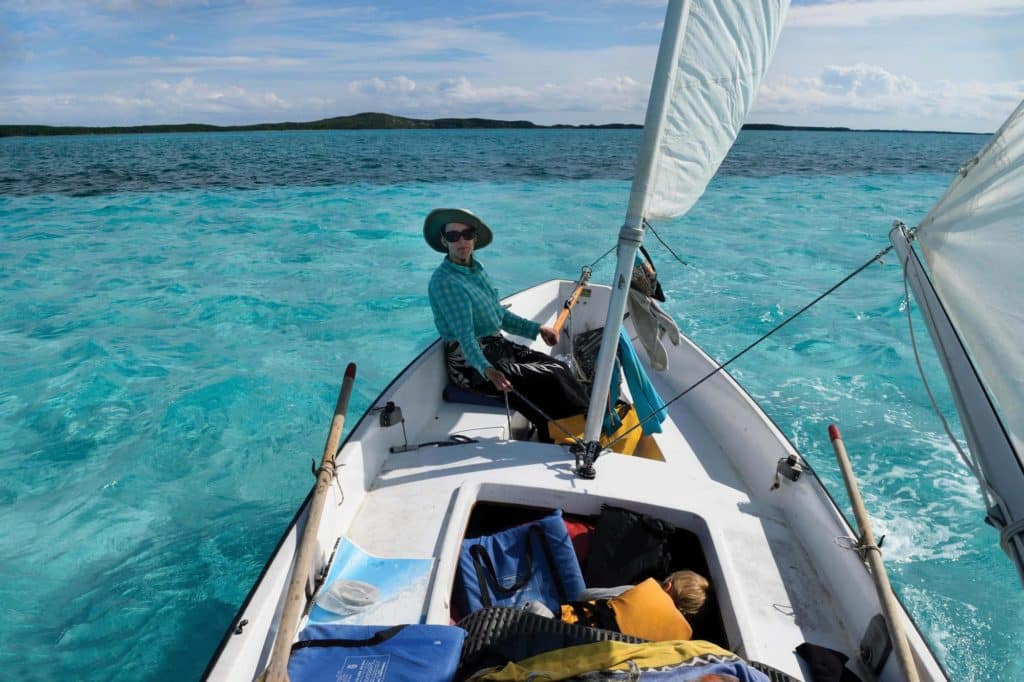
Water splashed over the bow as I held the Sea Pearl 21 tight to the wind. Glancing to port, I gauged the distance between our little boat and the nearby coral-laced cut between two deserted Bahamian cays. The tide was ebbing fast into the open ocean beyond, which meant we were fighting the current as well as the wind.
I guessed we were making 2 knots. Maybe. But I was grinning, exhilarated to finally be sailing across the bright blue waters I’d dreamed about for so long.
“We’re gonna round the point on this tack, Bri, I can feel it!” my husband, Rob, called. He was manning the clunky wooden oars from a makeshift seat on our cooler in the center of the boat. Rowing gave us a helpful boost since we had no motor aboard.
At Rob’s feet, our 3-year-old son, Talon, was napping in a yellow life jacket, using a dry bag as a pillow. I reached over to adjust our toddler’s hat to block the late-afternoon sun, then pulled in the mizzen another inch. And that’s when the 30-knot gust hit.
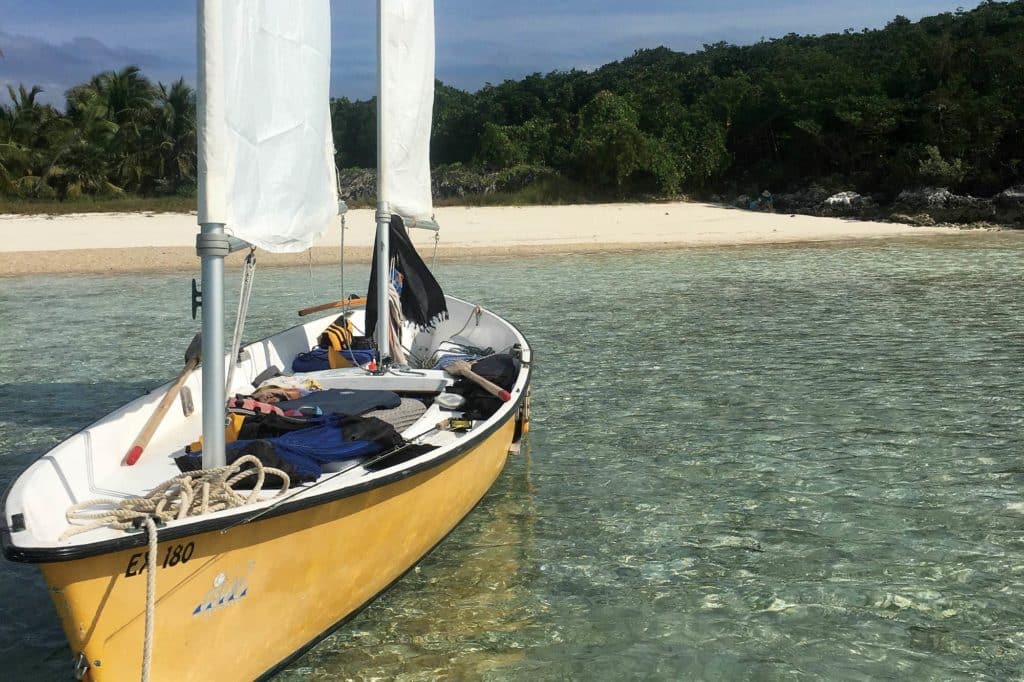
We were halfway through a weeklong bareboat cruise in the Exumas , a playground for anyone who loves white-sand beaches, clear-water snorkeling and cruising between deserted islands.
And when I say “bareboat,” I mean bare bones, as well as captainless. We chose to charter the Sea Pearl from Out Island Explorers for two reasons: first, affordability. At $1,000 for eight days, the price was one-fifth the cost of chartering a larger sailboat.
Second, accessibility. Hundreds of miles of shallow waters and shifting sands make the Exumas one of the most beautiful places on Earth—and one of the more challenging places to navigate without grounding. Sea Pearls draw only 8 inches with the daggerboards up, and their flat bottom allows them to be beached. Most monohulls can’t sail on the Bahama Banks side of the southern portion of the Exumas island chain, which means battling the rougher conditions on Exuma Sound and missing some of the most stunning anchorages in the area. Even shoal-draft catamarans risk grounding in many of the Exumas’ pocket bays, which drain completely at low tide.
The downside of chartering the Sea Pearl? It’s basically a big canoe. Without a cabin, we had to camp ashore every night.
Five days before, we’d done our food provisioning at the only grocery store in George Town, the main settlement on Great Exuma. The next morning, Dallas Knowles, owner of Out Island Explorers, picked us up, and we drove north to Barraterre Cay. The charter price included enough fresh water for our week at sea, packed in dromedary bags. We also rented a stove and fuel from Knowles at a nominal price, along with a couple of beach chairs and a small folding table—camping gear that was too bulky (or illegal) for airplane luggage.
At a small dock with no other boats in sight, Knowles showed us how to rig and sail the Sea Pearl. The sails slide on sleeves down two identical masts, one forward and the other aft, and are reefed by simply twisting the mast in its step. Sails are unfurled by pulling on the outhaul line along the boom. Two lead-weighted leeboards swing off the gunwales on either side, easily raised in shallow water by pulling a line and securing it in cam cleats on the rails. Without a keel, these boats don’t point particularly well and perform best downwind.
Knowles gave us charts and detailed descriptions of various anchorages and potential routes for our eight-day cruise. He also handed us a small repair kit and an old-school push-button cellphone to call him if we needed help or wanted a weather report. Then he threw us the dock lines, calling out: “Have fun! Be safe!” Talon waved goodbye as we sailed east toward Boysie Cay.
The first three nights we’d found private, pristine beaches where we could nose the Sea Pearl right up to shore. Winds had been light, but I hadn’t minded the lack of a motor. Calm conditions were great for snorkeling and fly-fishing from the boat, and the oars worked well for maneuvering the 700-pound Sea Pearl when becalmed.
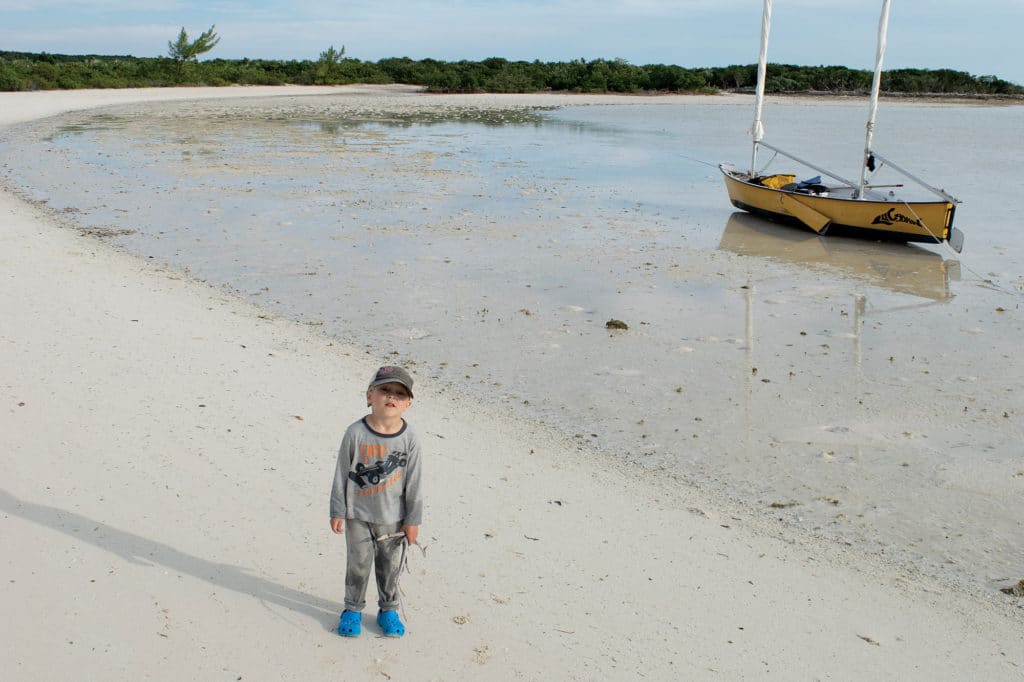
Day four had started out perfect for sailing. After a breakfast of eggs and bacon, we packed up camp on Normans Pond Cay, then sailed to the island’s northern shore in a lovely 15-knot breeze. Anchoring in a calm bay, we ate lunch on a deserted beach. Rob and I took turns exploring the reef while the other played tag in the sand with our son.
When it was my turn to snorkel, I dived down to spy on two big lobsters hiding under purple fan coral. The water in the Exumas was as clear as a looking glass, and rife with cool sea life. So far, we’d snorkeled alongside schools of snappers and jacks, stingrays, turtles, moray eels, and a reef shark.
Around 3 p.m., we reboarded the boat for the short 3-mile sail to Williams Cay, where we planned to camp that night in a well-protected bay. A norther was predicted to blow in around sunset. Since we could see whitecaps forming, we reefed both sails and donned foul-weather gear.
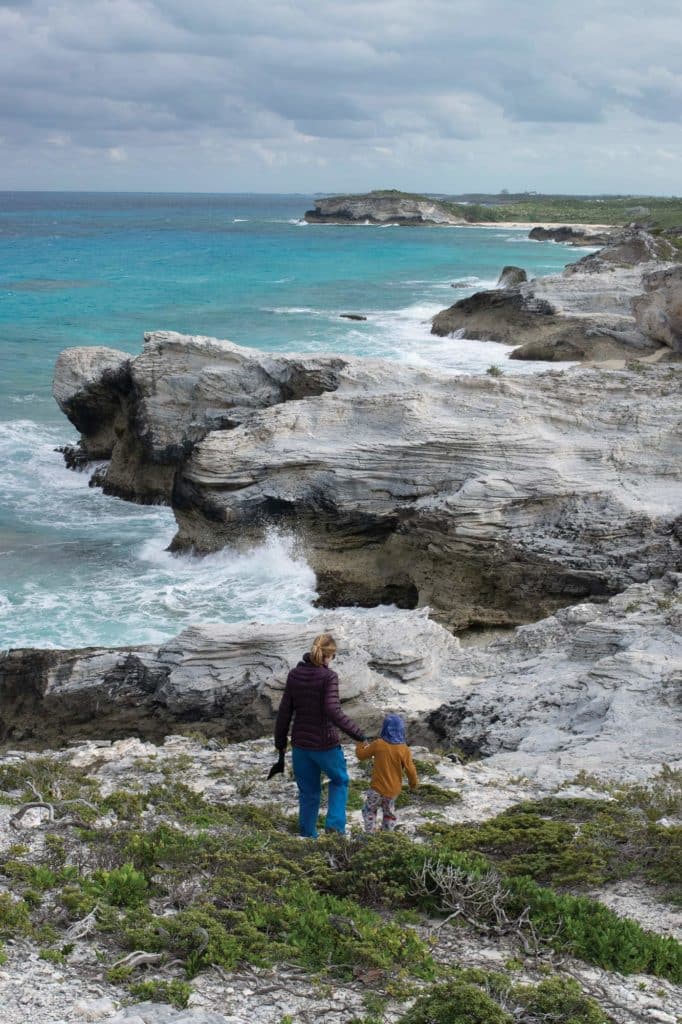
It had been fun sailing for the first half-hour, but then the wind began to howl from the direction we were trying to sail, and a current was steadily pushing us sideways. I was starting to wish for some iron horsepower, especially as a 30-knot gust hit us, just 300 yards from the point we were trying to round.
Rip! The mizzen tore above me, the wind rendering the sail to tatters. I lost steerage and couldn’t keep the boat pointed to windward with just the reefed main. Rob began rowing harder to give us more speed.
Crack! The starboard oar snapped in half. We exchanged a look of disbelief. The tide carried the Sea Pearl quickly toward the cut and the open water beyond.
We had to think fast so we didn’t end up on a reef. I turned the boat downwind toward a speck of white sand—the last holdout between us and the open ocean. Fifty yards from shore, Rob let out the mainsheet to slow us down, then hopped overboard to hold the boat off the rocks bracketing the beach.
I chucked the stern anchor over, then hopped in too, stubbing my bare toes on a piece of coral. The water was chest-deep. Waves buffeted the boat, turning it into a bucking battering ram as we struggled to secure it.
At the bow, Rob was trying to dive down to bury the main anchor in the sand, frustrated because he kept floating to the surface.
“You still have your life jacket on!” I yelled. He pulled it off, then set the anchor to keep the bow pointed into the wind and waves.
As Rob climbed back aboard to roll up the flogging sails and unrig the boat, I reached into the center hold, pulling up our son by his arms and hoisting him over my shoulder. Wading to shore, a part of me floating above the scene marveled at my adrenaline-fueled strength.
I put Talon gently on the sand in the shade of a large boulder. Miraculously, he stayed asleep. Rob started wading to shore, holding our day bag overhead—a backpack full of snacks, water, extra clothes, navigation charts and the emergency cellphone.
Closing my eyes, I took a deep breath, relieved that we were all safe. I took stock of our surroundings as I shed my sodden life jacket, foul-weather gear and clothes. An abandoned house stood above the small beach, its paint long peeled off. The sun, framed by billowing gray clouds, was only a couple of hands above the horizon. I could smell rain in the air. Waves rumbled like thunder on the outside reef.
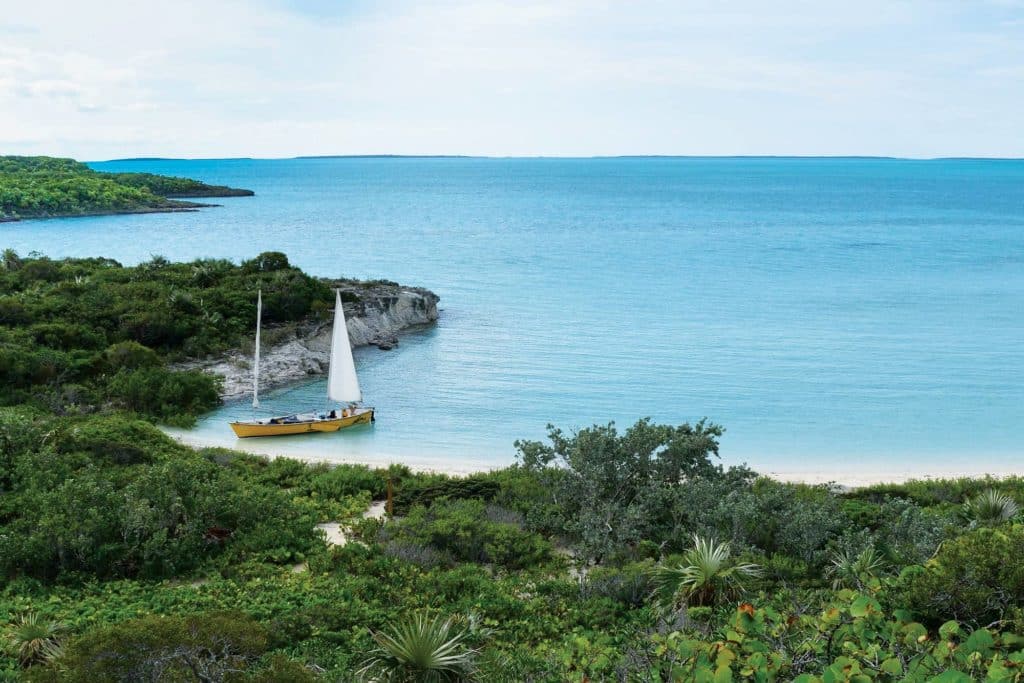
With the boat secure and all of us safe, I called Knowles to explain the situation. He came to the rescue two hours later in a twin-engine fishing boat, a new mizzen sail rolled up along the gunwale. Working fast in the fading evening light, we rigged a tow line on the Sea Pearl so Knowles could tow it to Twin Beach, the anchorage we’d originally been aiming for.
Talon—who’d taken our near-emergency in stride upon waking in the sand instead of in the cockpit—was thrilled about riding in a shiny, fast powerboat. He laughed as we sped across the choppy silver water.
“You handled yourselves well,” Knowles said. “That definitely could have been bad news.”
He never asked if we wanted to call it quits after the traumatic afternoon. Maybe he knew we’d say no.
As he helped us untie and anchor the Sea Pearl, Knowles told us the wind was supposed to get stronger that night, then clock around to the southeast. Rob asked whether we should take advantage of the wind shift to sail over to the rarely visited Brigantine cays for the last half of our trip.
“If you check out the Brigantines, you could tack up the Odi Creek to Barraterre and make a full loop,” Knowles suggested. “Just call me that morning and let me know if you want me to pick you up at the dock or at Odi Creek.”
After he zoomed off, we set up camp in record time. The rain began after we climbed into the tent, where we ate a cozy picnic dinner and read each other stories, grateful to be together and sheltered.
The next morning, we woke to clear skies, though the wind was still whipping up chop beyond our little bay. We took a rest day to regroup. While Rob stayed at camp, Talon and I went for a hike.
We climbed up a rocky ridge, spotting dozens of giant stingrays swimming in the shallows below us, their black bodies rippling like the skirts on a flamenco dancer. Then we headed to the other side of the island to treasure hunt, finding a washed-up soccer ball, a doll and a wooden sword. Back at camp, Talon created castles from pearly-pink conch shells—the ubiquitous (and tasty) Bahamian mollusk. That evening we collected firewood and made a bonfire, watching the moon rise and the Milky Way appear.
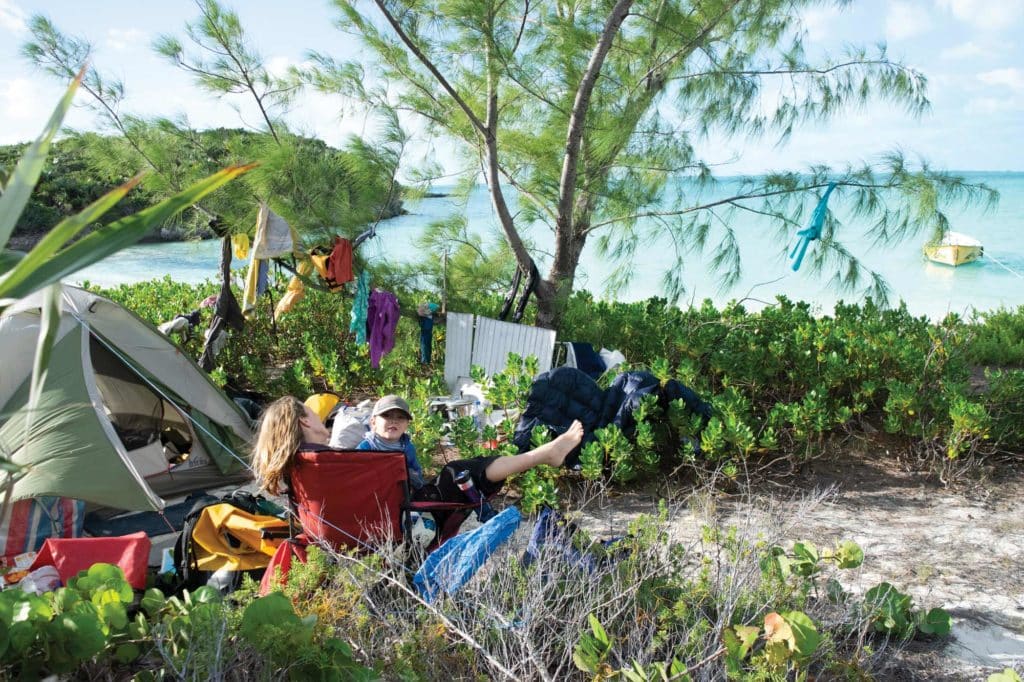
Rejuvenated, we set out early the following day for the Brigantines, taking our time to explore along the way. Talon and Rob fished from the boat for snapper at Tug and Barge rocks, while I snorkeled alongside two curious barracudas.
Though only 5 miles from the windward cays in the Exumas, the Brigantines felt very different—and even more remote. The water was a beautiful milky green due to limestone deposits, and the beaches were larger. Acres of silty-soft sand were exposed at low tide, where a maze of protruding mangrove roots arched over mounds made by clams. The Sea Pearl was perfect for gunkholing in these shallow waters. We saw only two other boats in two days, both manned by local fishermen.
We stopped to camp at a mile-long crescent of beach on Brigantine Cay. Talon helped collect coconuts to drink with our dinner of chicken and rice, proud of his tropical foraging skills. At sunset we set up hermit crab races, betting on whose temporary pet would make the finish line before getting distracted.
On our final day in the Exumas, the weather turned again. We stuck close to the mangroves to skirt the wind and waves as we headed back to Barraterre Cay. The last mile was almost comical—we had to tack at least four dozen times to sail up narrow Odi Creek. Luckily, we made it just before the rain started pouring down.
After hoisting ourselves into Knowles’ truck, I reached over to give him a high-five.
“No one I’ve chartered to has ever sailed all the way up Odi Creek,” Knowles admitted. “Most people choose the easier way back.”
“Yeah, we rarely choose the easy way,” I said with a laugh, winking at Rob. “But it usually leaves us with better stories to tell.”
Brianna Randall is a freelance writer and the founder of Adventure Families. She sails mountain lakes in Montana and cruises in the Bahamas any chance she gets.
- More: Bahamas , Destinations , exuma , family cruising , print 2021 may
- More Destinations

Paradise Pummeled

A Guide to Cruising Paperwork

Cruising Panama: Two Weeks in the Darién

A World Away: Cruising the Tobago Cays
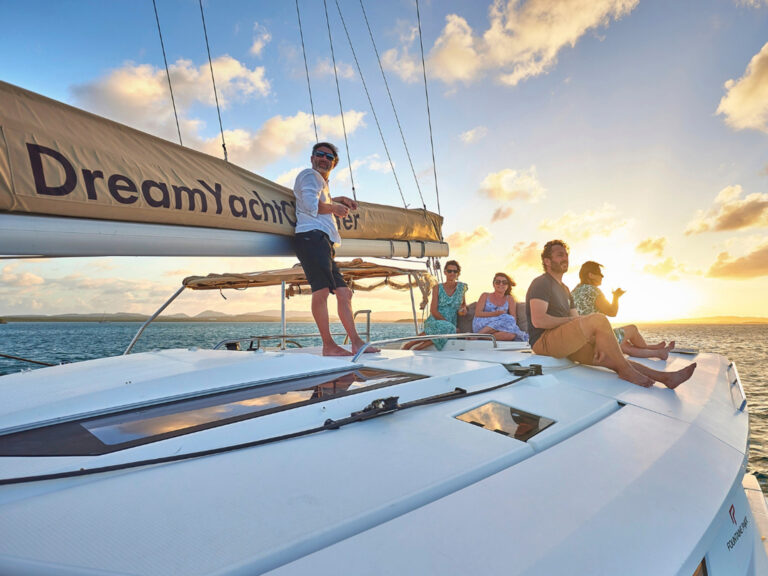
Options To Explore

For Sale: Little Harbor 63 Ketch
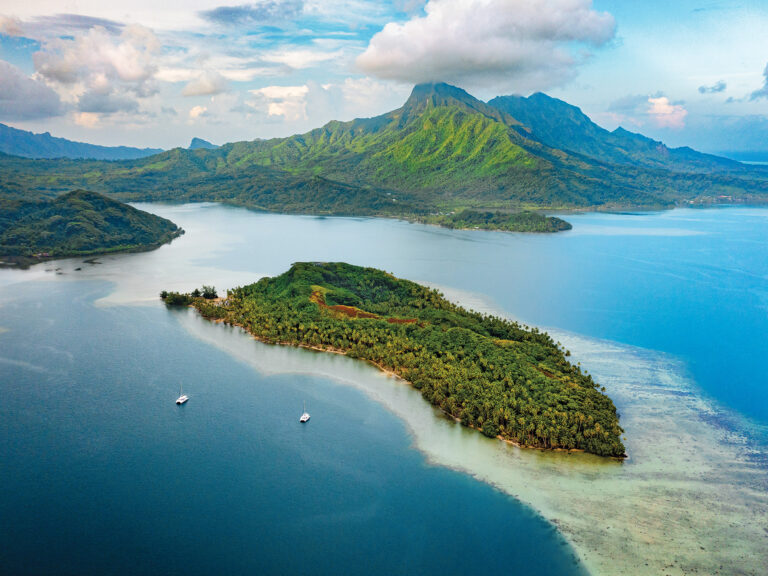
Cruising Tahiti: A Party in Paradise
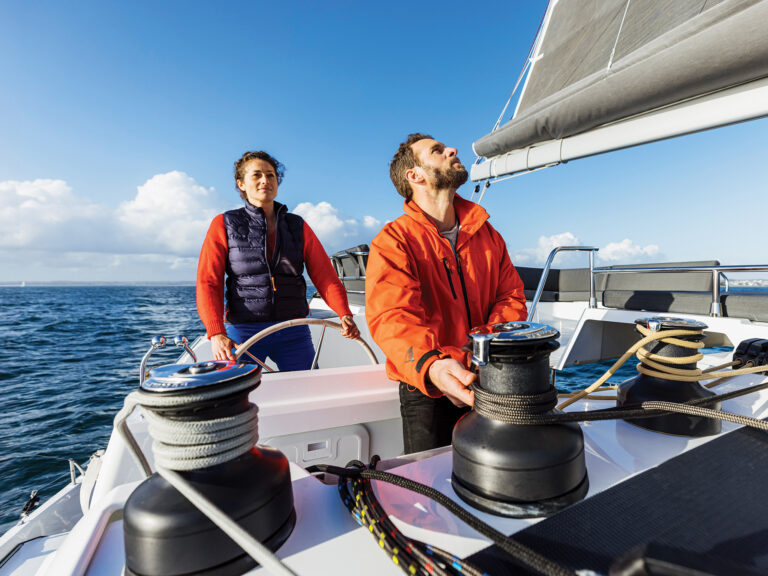
Sailboat Review: Fountaine Pajot Aura 51
- Digital Edition
- Customer Service
- Privacy Policy
- Terms of Use
- Email Newsletters
- Cruising World
- Sailing World
- Salt Water Sportsman
- Sport Fishing
- Wakeboarding

- Find A School
- Certifications
- North U Sail Trim
- Inside Sailing with Peter Isler
- Docking Made Easy
- Study Quizzes
- Bite-sized Lessons
- Fun Quizzes
- Sailing Challenge
Bahamas Adventure: The Sea Pearl 21 Sailboat
By: American Sailing American Sailing Association , Equipment , Flotillas , Sailboats

This was my first boat checkout standing knee deep in water for the briefing.
Most bareboat charter arrangements begin with a chart briefing and boat checkout, but this one was very unique. Dallas, our guide, explained the Sea Pearl 21 to the group.
The front sail is the Main and the back sail is the Mizzen. At the gooseneck there was a locking mechanism. When that mechanism was removed the masts would rotate, allowing the sail to furl around the mast. This is how we would reef and put away the sails.
Most of the boats had leeboards. This was a board on either side of the boat that would be lowered on the downwind side while sailing. The boats were wide open, putting a whole new meaning to the word “bareboating.” Our gear (tents and clothes) were stored in dry sacks aboard the boats.
Beaching the boats on the beautiful white sand beaches and camping at night: This was an amazing adventure.
Related Posts:

- Learn To Sail
- Mobile Apps
- Online Courses
- Upcoming Courses
- Sailor Resources
- ASA Log Book
- Bite Sized Lessons
- Knots Made Easy
- Catamaran Challenge
- Sailing Vacations
- Sailing Cruises
- Charter Resources
- International Proficiency Certificate
- Find A Charter
- All Articles
- Sailing Tips
- Sailing Terms
- Destinations
- Environmental
- Initiatives
- Instructor Resources
- Become An Instructor
- Become An ASA School
- Member / Instructor Login
- Affiliate Login

- Forums New posts Unanswered threads Register Top Posts Email
- What's new New posts New Posts (legacy) Latest activity New media
- Media New media New comments
- Boat Info Downloads Weekly Quiz Topic FAQ 10000boatnames.com
- Classifieds Sell Your Boat Used Gear for Sale
- Parts General Marine Parts Hunter Beneteau Catalina MacGregor Oday
- Help Terms of Use Monday Mail Subscribe Monday Mail Unsubscribe
sea pearl 21
- Thread starter ChuckThomas
- Start date Jul 14, 2008
- Forums for All Owners
- Ask All Sailors
ChuckThomas
Anyone have experience with this boat? Good? Bad?
LANCE ON CLOUD NINE
No personal experience but a very loyal following in S.W. Florida These guys seem to love them- both in standard form and with optional out riggers. From what I have read on their web sight, they are faster than you would guess. After going to their site, you can join their yahoo group and ask any specific questions. Good luck.
great boats a friend has one that we have sailed on. The boat is surprisingly fast, easy to sail, points well, and will sail in very shallow water. The motor mount on the tiller is a little different, but it doesn't take much horse power to move her. It has no cabin, but some folks overnight in them using boom tents, etc. Bert
Steve W (NY)
I have one.....never going to sell it! I have one. It is a fantastic trailer sailer. You can have it rigged in 10-15 minutes easily. and it's light enough I pull it with a Pontiac Vibe. I sail with my family of five (we pull it with a minivan when they all go), and park it in my barn and it costs me nothing. West Marine becomes a place you vaguely remember, because the boat is so simple and the improvements you can make are minimal. Sailing in 10" of water is really fun, and being able to reef the sails down to hankerchiefs makes it even fun on days other trailer sailers are struggling. I went to Canandaigua Lake this past saturday and watched a couple of trailer sailors with sloop rigs spend time stepping masts with two people, and I just picked up the masts, stuck them in the steps, attachd the rudder and placed my Honda 2hp on and was ready for the ramp. Sailing is great, they move nice in even the lightest breeze. If there is a fault, it's that you have to be careful and not pinch, as the Cat-Ketch rig doesn't quite point like a sloop. But I was able to make upwind progress on par with an O'day Daysailer and a larger (maybe a tanzer 22...not sure) by not pointing as high but making faster boat speed. On a reach it's not a fair fight, I commonly sail at 6+ knots and have had it at 9 knots once. running is another place where a Cat-Ketch rig is nice....you can wing out the main to port and mizzen to starboard, and it really scoots. I chased a Watkins boat about 25 feet with a chute and I couldn't pass him, but I stayed right with him. I couldn't love a boat more. Take Care, Steve
thanks for the input. i am thinking about giving one to my son for his 21st birthday? what do you think?
Steve w (NY)
Igot a big student loan for my 18th birthday....and a card for my 21st. They are about 17 grand new...... Take Care, Steve
- This site uses cookies to help personalise content, tailor your experience and to keep you logged in if you register. By continuing to use this site, you are consenting to our use of cookies. Accept Learn more…

Sea route & distance
find start port:
find destination port:
start typing to see the suggestions
Distance: nautical miles
time at sea
Paste link in email:
© 2010-2023 Ports.com
- Northern Europe & Baltic Sea
COST of day trip to Moscow ??
By densol , February 26, 2012 in Northern Europe & Baltic Sea
Recommended Posts

We have just booked a cruise to the Baltics for next year. I am trying to find out the average cost for a day trip to Moscow from STP. I have searched several times, and whilst I have read reviews and reports about the trips etc - I cannot actually see any examples of the costs. I imagine its quite expensive - but we want to do it so I need to budget LOL !!
Any ballpark figures ? :D
Link to comment
Share on other sites.

We have just booked a cruise to the Baltics for next year. I am trying to find out the average cost for a day trip to Moscow from STP. I have searched several times, and whilst I have read reviews and reports about the trips etc - I cannot actually see any examples of the costs. I imagine its quite expensive - but we want to do it so I need to budget LOL !! Any ballpark figures ? Thanks
We did the Moscow trip through our cruise ship in late July 2008. Its cost was a little under $1000 pp. Now, that cost through this cruise line is a little over that $1000 pp cost. Now, most are using the high-speed rail connection versus the air flights as we did. I have seen some other numbers from other cruise lines and/or private firms that run $700-850.
Why cheaper or the differences? As cruise lines are pressured to keep their "sticker price" low, they need to make up some "margin" with ship tours, beverages, spa stuff, etc., to help cover their costs and gain some profit. Second, different tours provide various features. Our tour included going inside the famed and spectacular Kremlin Palace. Most Moscow tours don't feature that option and you cannot just walk up there and get in on your own. That Palace is where the Czars were crowned and all of the current/recent Russian leaders assumed their powers.
We could have saved a little if we had used a private tour to go to and visit Moscow, but, with my wife's pushing, we felt it was worth it to pay a little more, do it through the cruise line. If there had been any problems or mix-ups, it was the ship's duty to "make it right" and we would not have to worry.
If you have three days in St. Petersburg and/or have been there before, then the Moscow tour can work out very well. It's not cheap, but in my view, worth it!! Both are a few of my visuals from this super great city with such interesting history and dramatic architecture.
THANKS! Enjoy! Terry in Ohio
Did a June 7-19, 2011, Solstice cruise from Barcelona that had stops in Villefranche, ports near Pisa and Rome, Naples, Kotor, Venice and Dubrovnik . Enjoyed great weather and a wonderful trip. Dozens of wonderful visuals with key highlights, tips, comments, etc., on these postings. We are now at 66,454 views for this live/blog re-cap on our first sailing with Celebrity and much on wonderful Barcelona. Check these postings and added info at:
http://www.boards.cruisecritic.com/showthread.php?t=1426474
For details and visuals, etc., from our July 1-16, 2010, Norway Coast/Fjords/Arctic Circle cruise experience from Copenhagen on the Silver Cloud, check out this posting. This posting is now at 60,364 views.
http://www.boards.cruisecritic.com/showthread.php?t=1227923
One of the Kremlin Wall Towers in Moscow:
Walking on the famed Red Square of Moscow:
St. Basil's sits on Red Square and dates back to its 1555-61 construction on the orders of Ivan the Terrible (Ivan IV). It commemorates the capture of Kazan and Astrakhan and marks the geometric center of the city. This location has been the hub of its growth for Moscow since the 14th century. It was the tallest building in Moscow until the completion of the Ivan the Great Bell Tower in 1600. This church was near destroyed in the 1930’s when Stalin was in control.:
Here is a small sampling of the Kremlin Royal Treasures of the Czars: Eggs & Jewels insicde the famed Armory.:
Moscow’s subways are called the “People’s Palaces” with their marble coverings and unique designs for each of the different and many stations.:
This is the interior for Moscow's most historic church, Assumption Cathedral or the Cathedral of the Dormition, inside the Kremlin walls. It is the mother church of Muscovite Russia. The church stands on Cathedral Square and was built in 1475–1479 by the Italian architect Aristotele Fioravanti. It was erected on the spot of an older 14th century cathedral of the same name:

We did the day trip to Moscow with Alla-tour and were very pleased with our tour. Our guide whose English was great was a wealth of information and the day went very smoothly. I checked the web site and Alla's prices for 2012 range from $884 a person for two down to $542 a person for 6 with the 5% cruisecritic discount. So if you can get a group together the per person price goes down considerably. You can try to do this on the roll call section of cruisecritic.
We did not go to the Palace and as Terry says this is not included generally in tours. However, we did go to the Diamond Fund, an amazing display of crown jewels and jewelry in the Armoury building but not really part of the Armoury. I would think you could include this if you had a small group and really wanted to see it. It is quite small and does not accommodate a large group. You can google "diamond fund kremlin" to learn more.
Here are some of my pictures
Red Square with St. Basil’s at the far end
Kremlin Cathedral Square
Bolshoi Theatre
Treasures at the Armoury
200 ton Tsar Bell
Tomb of the Unknown Soldier

We did the day trip to Moscow with Alla-tour and were very pleased with our tour. Our guide whose English was great was a wealth of information and the day went very smoothly. I checked the web site and Alla's prices for 2012 range from $884 a person for two down to $542 a person for 6 with the 5% cruisecritic discount. So if you can get a group together the per person price goes down considerably. You can try to do this on the roll call section of cruisecritic. We did not go to the Palace and as Terry says this is not included generally in tours. However, we did go to the Diamond Fund, an amazing display of crown jewels and jewelry in the Armoury building but not really part of the Armoury. I would think you could include this if you had a small group and really wanted to see it. It is quite small and does not accommodate a large group. You can google "diamond fund kremlin" to learn more.
Well said, cadreamer! (nice photos, by the way).
We also used Alla. She is just a super person to work with and, if you get a group together, she will accomodate what YOU want to do!! You can check-out her Moscow tour at:
http://www.alla-tour.com/tours/1
As cadreamer suggests, go to your roll call on Cruise Critic & see if you can get a group together.
Terry, your pix, per usual, are awesome! Still envious! :)
Terry, your pix, per usual, are awesome! Still envious! :) jill
Appreciate, Jill, the kind comments! Envy is GOOD!!
Below are a few more visuals on Moscow that are more "interesting". Fascinating to having seen both cities, back-to-back. It really puts all of this unique Russian history and architecture in better perspective.
Did a June 7-19, 2011, Solstice cruise from Barcelona that had stops in Villefranche, ports near Pisa and Rome, Naples, Kotor, Venice and Dubrovnik . Enjoyed great weather and a wonderful trip. Dozens of wonderful visuals with key highlights, tips, comments, etc., on these postings. We are now at 67,001 views for this live/blog re-cap on our first sailing with Celebrity and much on wonderful Barcelona. Check these postings and added info at:
The famed KGB (Secret Police) Headquarters in Moscow where many entered and did not exit (alive) during the 1950’s and 1960’s:
Kremlin Treasures: Royal coaches:
Young Military Officers on the streets of Moscow with Soviet "High Hat".:
These are the series of smaller domes on the top of the Church of the Deposition of the Robe in the Kremlin Cathedral Square area.:
Inside the newly, more westernized GUM Department Store:
This topic is now archived and is closed to further replies.
- Welcome to Cruise Critic
- Hurricane Zone 2024
- Cruise Insurance Q&A w/ Steve Dasseos of Tripinsurancestore.com Summer 2024
- New Cruisers
- Cruise Lines “A – O”
- Cruise Lines “P – Z”
- River Cruising
- Cruise Critic News & Features
- Digital Photography & Cruise Technology
- Special Interest Cruising
- Cruise Discussion Topics
- UK Cruising
- Australia & New Zealand Cruisers
- Canadian Cruisers
- North American Homeports
- Ports of Call
- Cruise Conversations
Announcements
- New to Cruise Critic? Join our Community!
Ask Me Anything About
Victory Cruise Lines!

Ask Your Questions Today;
See answers beginning August 12th

Write Your Own Amazing Review !

Click this photo by member XFrancophileX to share your review w/ photos too!
Parliament, Budapest
Features & News

LauraS · Started Wednesday at 02:31 PM
LauraS · Started Wednesday at 11:32 AM
LauraS · Started Wednesday at 07:31 AM
LauraS · Started August 15
LauraS · Started August 14

Cruise Planning
Find a cruise, popular ports, member reviews.
© 1995— 2024 , The Independent Traveler, Inc.
- Existing user? Sign in OR Create an Account
- Find Your Roll Call
- Meet & Mingle
- Community Help Center
- All Activity
- Member Photo Albums
- Meet & Mingle Photos
- Favorite Cruise Memories
- Cruise Food Photos
- Cruise Ship Photos
- Ports of Call Photos
- Towel Animal Photos
- Amazing, Funny & Totally Awesome Cruise Photos
- Write a Review
- Live Cruise Reports
- Member Cruise Reviews
- Create New...
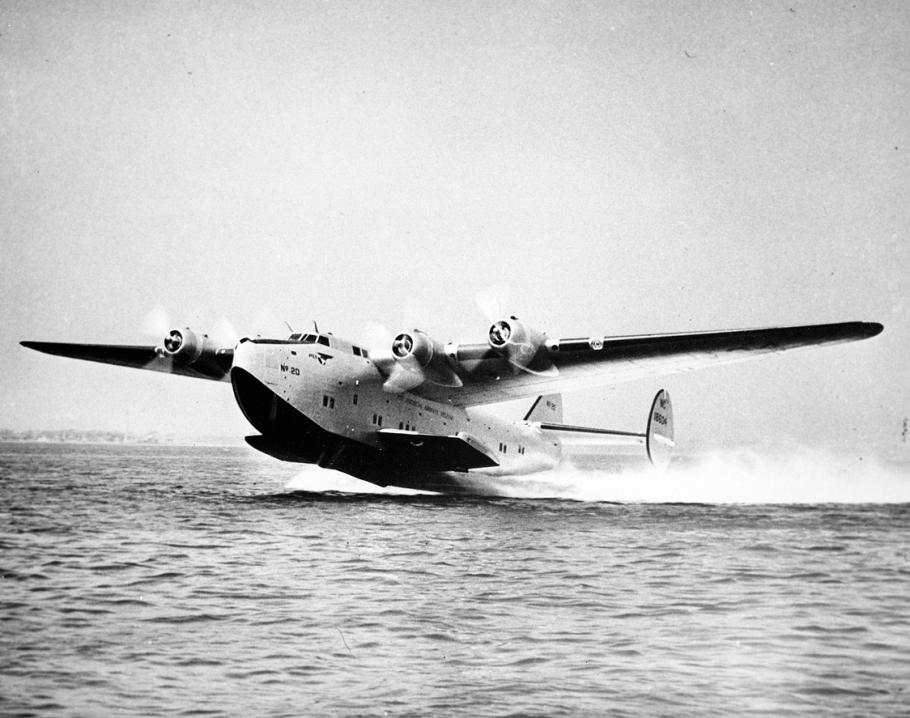
Pan Am Boeing 314.
Stranded. Six days from its home port of San Francisco, a luxurious Boeing 314 flying boat, the Pacific Clipper , was preparing to alight in Auckland, New Zealand, as part of the airline’s transpacific service when the crew of ten learned of the Japanese attack on the U.S. fleet at Pearl Harbor on the morning of December 7, 1941. All across the Pacific, Pan Am facilities came under assault: Wake Island, where the Martin M-130 Philippine Clipper returned just in time to pick up the Pan Am staff and escape although riddled with bullet holes; Manila, which had come under direct air attack; Hong Kong, where a Sikorsky S-42B was destroyed at its dock; and, of course, Pearl Harbor. Where to go?
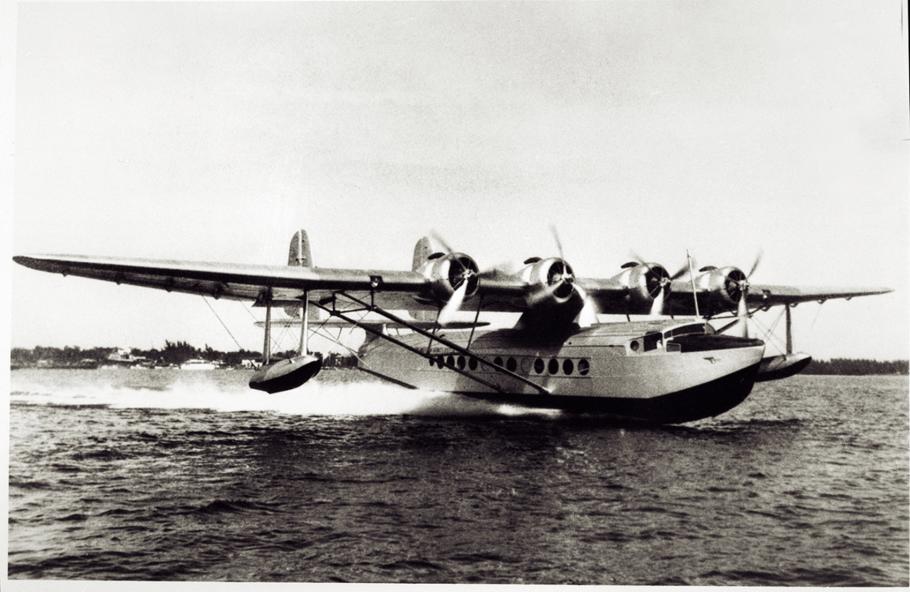
Pan Am Captain Robert Ford was faced with a dilemma. After a week in the U.S. Embassy Ford finally received word from Pan Am headquarters that they were to return to the U.S. by flying westward. They were on their own for gasoline and supplies and had to fly over land and water with which none of the crew was familiar. With orders in hand, Captain Ford took off on December 16th, unsure of his fate, backtracked to Noumea, New Caledonia, to pick up the Pan Am staff left there and headed west for Australia. Hours later, they put down in Gladstone, north of Brisbane on the Coral Sea. The next day, Captain Ford and the Pacific Clipper headed northwest to Darwin, flying over the Queensland desert and watching it gradually transform into tropical rainforest near their destination of Darwin. The next goal was Surabaya, in the Dutch East Indies (present day Indonesia). Keeping their fingers crossed that the Japanese expansion had not reached this far, the crew of the massive flying boat flew 2,253 kilometers (1,400 miles) over open ocean and reached the city but not before they were intercepted by suspicious British fighter aircraft and escorted in to safety after taxiing through mined waters.
After refueling with automobile grade gasoline, since no 100 octane fuel was available, the Pacific Clipper carefully took off and headed for Trincomalee, Ceylon (now Sri Lanka) without any charts, only the coordinates of their destination. With remarkable precision, navigator Roderick Brown found the island and the port city where they alighted safely, although only after avoiding a patrolling Japanese submarine. Refueling once again, the Boeing 314 left Trincomalee on Christmas Eve only to turn back after losing an engine. Repairs took all day on Christmas before they retook to the air on Boxing Day bound for Karachi, India (now Pakistan). After an uneventful flight, Captain Ford continued safely on to Bahrain and then across the vast desert expanse of the Arabian peninsula to Khartoum, Sudan, where they alighted on the Nile. Not wishing to risk any further desert flying, the crew of the Pacific Clipper pressed on to Leopoldville in the Belgian Congo (now Kinshasa in the Democratic Republic of the Congo) and was able to put the huge flying boat down on the Congo River when they reached their destination.
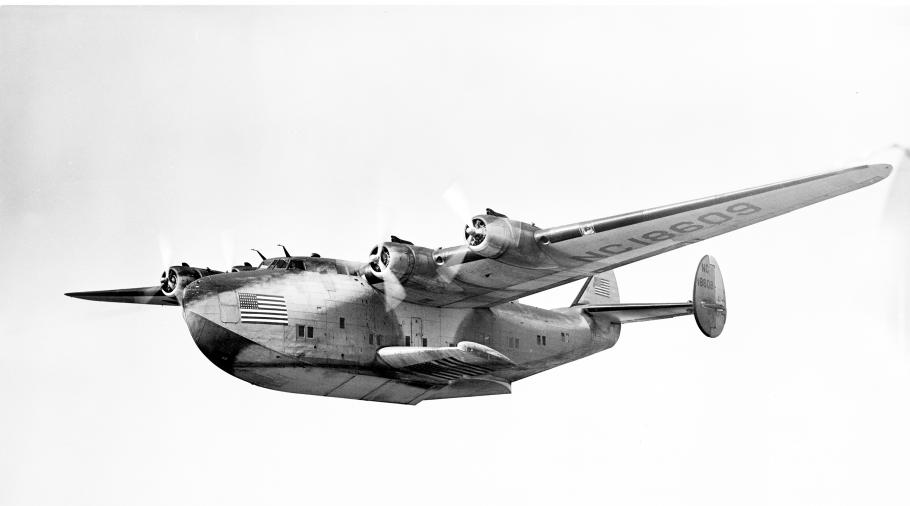
To avoid flying across the Pacific after the attack on Pearl Harbor, the Pacific Clipper flew westward, three-fourths of the way around the world, to New York.
Fighting the oppressive heat and the strong current of the river, the flying boat once again clawed into the sky becoming airborne before reaching a set of waterfalls. Safely clear of the obstacles, the Pacific Clipper droned 5,766 kilometers (3,583 miles) westward to Natal, Brazil, then up the coast to Port of Spain, Trinidad, and finally on January 6, 1942, to the Marine terminal at La Guardia, Long Island, New York. Total flight time was 209 hours which covered 50,694 kilometers (31,500 miles). It was the first around the world flight by a commercial airliner — the hard way.
After this historic flight, the Pacific Clipper was assigned to the U.S. Navy for the rest of World War II. When the War ended, the aircraft was sold to Universal Airlines who salvaged it after it was damaged in a storm.
Have you ever had a harrowing flight experience? Tell us about it.
We rely on the generous support of donors, sponsors, members, and other benefactors to share the history and impact of aviation and spaceflight, educate the public, and inspire future generations. With your help, we can continue to preserve and safeguard the world’s most comprehensive collection of artifacts representing the great achievements of flight and space exploration.
- Get Involved
- Host an Event
Thank you. You have successfully signed up for our newsletter.
Error message, sorry, there was a problem. please ensure your details are valid and try again..
- Free Timed-Entry Passes Required
- Terms of Use
Loading map...
Nautical Distance Calculator
Our tool is the most advanced nautical miles calculator available, designed to help you estimate the sailing time, fuel consumption, and cost of your upcoming boat trip.
To mark a port or stop on your sea route, simply click or tap on the desired location on the map. Add as many points as necessary, and a line representing your route will automatically appear. Use the zoom in and zoom out features, or press 'Fit Map' to adjust the view and better visualize your trip on the map.
The total sea distance, measured in nautical miles (or kilometers), is displayed in the bottom right corner of the map.
With the travel time and sea distance calculator located below the map, you can estimate the duration of your trip and its total cost. Just enter the average speed, fuel consumption per hour, and the cost of fuel per liter or gallon.
If you want to move a port or stop, simply click (or tap) on it and, without releasing, drag it to the desired location on the map..
To remove any stop or port from your route, click on it and then press 'Remove' on the pop-up that appears. To delete the entire route and start over, click 'Clear Map'.
Once you've finalized your route, you can share all the details, including the sea route information, by clicking the 'Share' button located at the top right corner of the map.
Finally keep in mind that you can switch to kilometers instead of nautical miles.
For instance, if you plan to sail from Palermo to Naples using our sea distance calculator, you would find that the total distance is approximately 167 nautical miles (310 kilometers). With an average speed of 15 knots, it would take about 11.2 hours to complete this journey.
Great choice! Your favorites are temporarily saved for this session. Sign in to save them permanently, access them on any device, and receive relevant alerts.
- Sailboat Guide
1996 Sea Pearl 21
- Description
Seller's Description
Go to Sailing Texas classifieds for current sailboats for sale Sea Pearl 21, 1996 sailboat for sale $6500 (with outboard) $6000 (without) 996 Sea Pearl 21 manufactured by Marine Concepts, 21 feet.
Length 21’, beam 5’6”, Draft 6”, Lee board down 2’6”. Boat weighs in at approximately 600lbs. Aft cockpit is self bailing. Has water ballast, very stable in higher winds. Sails are reefable by turning both mast and mizzen to reduce sail area. Sail area 136 sq. Ft. Comes with two sets of sails. Comes with tonneau cover (tent) to sleep down below deck when camp cruising. Masts are freestanding and require no stays, takes me 15 min to set up from arriving at marina to in the water with everything ready for a day sail. Has oars for auxiliary propulsion for easy maneuverability around small areas or if no wind. Outboard is a 2.3 horsepower Honda outboard almost practically new! I might have 3 hrs total on the engine. If asking price is met, outboard will go with boat. Has continental trailer with spare tire. Bunks could use new covers.
located currently in Klamath Falls Oregon.
Rig and Sails
Auxilary power, accomodations, calculations.
The theoretical maximum speed that a displacement hull can move efficiently through the water is determined by it's waterline length and displacement. It may be unable to reach this speed if the boat is underpowered or heavily loaded, though it may exceed this speed given enough power. Read more.
Classic hull speed formula:
Hull Speed = 1.34 x √LWL
Max Speed/Length ratio = 8.26 ÷ Displacement/Length ratio .311 Hull Speed = Max Speed/Length ratio x √LWL
Sail Area / Displacement Ratio
A measure of the power of the sails relative to the weight of the boat. The higher the number, the higher the performance, but the harder the boat will be to handle. This ratio is a "non-dimensional" value that facilitates comparisons between boats of different types and sizes. Read more.
SA/D = SA ÷ (D ÷ 64) 2/3
- SA : Sail area in square feet, derived by adding the mainsail area to 100% of the foretriangle area (the lateral area above the deck between the mast and the forestay).
- D : Displacement in pounds.
Ballast / Displacement Ratio
A measure of the stability of a boat's hull that suggests how well a monohull will stand up to its sails. The ballast displacement ratio indicates how much of the weight of a boat is placed for maximum stability against capsizing and is an indicator of stiffness and resistance to capsize.
Ballast / Displacement * 100
Displacement / Length Ratio
A measure of the weight of the boat relative to it's length at the waterline. The higher a boat’s D/L ratio, the more easily it will carry a load and the more comfortable its motion will be. The lower a boat's ratio is, the less power it takes to drive the boat to its nominal hull speed or beyond. Read more.
D/L = (D ÷ 2240) ÷ (0.01 x LWL)³
- D: Displacement of the boat in pounds.
- LWL: Waterline length in feet
Comfort Ratio
This ratio assess how quickly and abruptly a boat’s hull reacts to waves in a significant seaway, these being the elements of a boat’s motion most likely to cause seasickness. Read more.
Comfort ratio = D ÷ (.65 x (.7 LWL + .3 LOA) x Beam 1.33 )
- D: Displacement of the boat in pounds
- LOA: Length overall in feet
- Beam: Width of boat at the widest point in feet
Capsize Screening Formula
This formula attempts to indicate whether a given boat might be too wide and light to readily right itself after being overturned in extreme conditions. Read more.
CSV = Beam ÷ ³√(D / 64)
This listing is presented by SailingTexas.com . Visit their website for more information or to contact the seller.
View on SailingTexas.com
Embed this page on your own website by copying and pasting this code.
- About Sailboat Guide
©2024 Sea Time Tech, LLC
This site is protected by reCAPTCHA and the Google Privacy Policy and Terms of Service apply.

IMAGES
COMMENTS
It takes into consideration "reported" sail area, displacement and length at waterline. The higher the number the faster speed prediction for the boat. A cat with a number 0.6 is likely to sail 6kts in 10kts wind, a cat with a number of 0.7 is likely to sail at 7kts in 10kts wind. KSP = (Lwl*SA÷D)^0.5*0.5
The Sea Pearl 21 is a recreational dinghy or a keelboat, if fitted with the optional ballast tanks holding 360 lb (163 kg) of water.The boat is built predominantly of fiberglass, with wood trim and has forward decking.It is a cat rigged ketch, with two unstayed masts.A lug sail rig was optional. The hull has a raked stem; an angled, canoe transom; a transom-hung rudder controlled by a tiller ...
Review: Sea Pearl 21. Convenient and capable, the Marine Concepts Sea Pearl is a trailersailing jewel. The eminent L. Francis Herreshoff called his Walrus design a "man's boat.". A motorsailer, Walrus carried 755-square-feet of sail, two 65-horsepower gasoline engines, and a pot-bellied stove in her saloon.
Sea Pearl preowned sailboats for sale by owner. Sea Pearl used sailboats for sale by owner.
Soon afterward I sold my deep-draft sailboat and bought Whisper, my Sea Pearl 21. Now I could get to, say, Charlotte Harbor at the head of Gasparilla Sound in two hours instead of three days. This, in turn, meant I had that much more time to study the sea grasses flowing with the tide and count the crabs on the bottom while exploring the ...
Long lead-weighted leeboards swung off the gunwhales on either side, controlled by a simple cam-cleat arrangement on the rails. Rigging the Sea Pearl 21 is a simple process, even in higher winds. The twin triangular sails slide over the masts via sleeves along the luff, and they furl around the rotatable masts.
An instructional video from Out-Island Explorers on how to properly rig and sail a Sea Pearl Sailboat. For those looking to rent a boat from us, this video ...
Sea Pearl 21 is a 20′ 11″ / 6.4 m monohull sailboat designed by L. Francis Herreshoff and built by Marine Concepts starting in 1982. ... Sail area in square feet, derived by adding the mainsail area to 100% of the foretriangle area (the lateral area above the deck between the mast and the forestay). D: ...
A young family chooses a different sort of cruising experience when they charter a 21-foot Sea Pearl for a week in the Bahamas' Exuma Islands. With the mainsheet in one hand and the tiller in the other, the author sails the Sea Pearl through the turquoise Bahama Banks. Rob Roberts. Water splashed over the bow as I held the Sea Pearl 21 tight ...
Sea Pearl 21 (Tri) is a 20′ 11″ / 6.4 m trimaran sailboat designed by Marine Concepts and built by Marine Concepts starting in 1993. ... Sail area in square feet, derived by adding the mainsail area to 100% of the foretriangle area (the lateral area above the deck between the mast and the forestay). D: ...
Dallas, our guide, explained the Sea Pearl 21 to the group. The front sail is the Main and the back sail is the Mizzen. At the gooseneck there was a locking mechanism. When that mechanism was removed the masts would rotate, allowing the sail to furl around the mast. This is how we would reef and put away the sails. Most of the boats had leeboards.
Anywhere in the Gulf Of Mexico a bimini top takes priority over performance. Sometimes the characteristics of the sailing area and the sailing style of the boat owner promotes changes to the boat's original sail plan. While a cruising sailor may seek some comfort a day sailor may look for performance.
Jul 15, 2008. #3. great boats. a friend has one that we have sailed on. The boat is surprisingly fast, easy to sail, points well, and will sail in very shallow water. The motor mount on the tiller is a little different, but it doesn't take much horse power to move her. It has no cabin, but some folks overnight in them using boom tents, etc. Bert.
Preview: Virtues of a Small Boat, Gunkholing in a Sea Pearl 21. OffCenterHarbor.com is a membership website with over 1,000 videos and articles on boat handling, repairs, maintenance, boat building, dream boats and more. Sign up above to learn more, and get 10 of our best videos. Whether it's 5,000 miles on the Great Eastern Loop or tucking ...
Prices start at $16,000 for a new monohull model, with Sport-Tri models starting at $21,600. Today's Sea Pearl is truly an easy boat to sail, is simple to maintain and a joy to own. You can actually sail in waters so shallow that you can hear the turtle grass running across the bottom of the hull.
Seller's Description. 1986 Marine Concepts Sea Pearl 21 sailboat, refitted at the factory in 1996, converted to full trimaran with wing decks and battened sails. Cat ketch rig. 2 identical masts and sails. Rigged by 1 person in 45 minutes, 30 minutes with 2 people. Nothing heavier than 40 lbs.
The head is under the V-berth. Headroom is 5 feet, 1 inch. This is an interior for a close family. The SeaPearl 28 carries 50 gallons of water. You can use up to a 15-horsepower motor. The hull is balsa cored and hand laid up. In an area where you can spend most of the time outdoors this would be an attractive small cruising boat.
Eine zweijährige Auszeit unter Segeln entlang der Barfußroute - Wir drücken auf „Pause" für den klassischen Lebensweg, um die schönsten Ecken der Erde auf unserer Sea Pearl zu entdecken.
Calculate sea route and distance for any 2 ports in the world.
We have just booked a cruise to the Baltics for next year. I am trying to find out the average cost for a day trip to Moscow from STP. I have searched several times, and whilst I have read reviews and reports about the trips etc - I cannot actually see any examples of the costs. I imagine its qui...
Pan Am Boeing 314. Stranded. Six days from its home port of San Francisco, a luxurious Boeing 314 flying boat, the Pacific Clipper, was preparing to alight in Auckland, New Zealand, as part of the airline's transpacific service when the crew of ten learned of the Japanese attack on the U.S. fleet at Pearl Harbor on the morning of December 7 ...
For instance, if you plan to sail from Palermo to Naples using our sea distance calculator, you would find that the total distance is approximately 167 nautical miles (310 kilometers). With an average speed of 15 knots, it would take about 11.2 hours to complete this journey. Check your sea route from port to port and estimate the distance the ...
A mother has told of how she kept her one-year-old daughter alive in the sea after Mike Lynch's yacht sank off the coast of Sicily.. Charlotte Golunski, 38, a senior associate at Invoke, Mr ...
Go to Sailing Texas classifieds for current sailboats for sale Sea Pearl 21, 1996 sailboat for sale $6500 (with outboard) $6000 (without) 996 Sea Pearl 21 manufactured by Marine Concepts, 21 feet.. Length 21', beam 5'6", Draft 6", Lee board down 2'6". Boat weighs in at approximately 600lbs. Aft cockpit is self bailing. Has water ballast, very stable in higher winds.